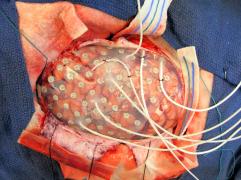Epilepsy
Key Points
- The largest team of pediatric epilepsy neurologists
- All modes of preoperative evaluation, including 3 Tesla MRI and MEG (Magnetoencephalography)
- Excellent Outcomes. Epilepsy surgery offers a chance of a cure when years of medication have failed
What is Epilepsy?
Epilepsy is a brain disorder that is characterized by repeated episodes of seizures or convulsions. The diagnosis is first made by taking a detailed medical history and gathering as much information about the episodes as possible. It is especially important to obtain any details the patient may remember and/or the observations from those who witnessed the incident. Next, a careful physical examination is performed with a focus on the function of the patient’s nervous system. Often, patients with newly diagnosed epilepsy are prescribed a starting dose of a medicine to help prevent seizures.

Patients with a suspected diagnosis of epilepsy will need a special study called an electroencephalogram (EEG). This test monitors and measures both the normal and abnormal electrical activity of the brain. The EEG records brain wave activity by using tiny wires taped to the scalp. It is completely painless and patients are able to watch television, play video games, etc. during the study. Depending on the patient, the study may last for a day or longer. Occasionally, we may attempt a trial of sleep deprivation or the lowering of seizure medicines to "bring out" the seizures, allowing us to capture them on the EEG. This is done with a grid of electrodes positioned on the surface of the brain.
MRI's of the brain are taken to look for an underlying tumor or abnormal anatomy that may be causing the patient’s seizures. Additional imaging techniques commonly used to search for the source of a patient’s seizures include a Positron Emission Tomography (PET) scan and a Magnetoencephalograpy (MEG).
Epilepsy Treatment Options
In many cases, drug therapy alone may control the frequency and strength of a child’s seizures. As with many medical conditions, it may take some trial and error before the optimal dosage and drug combination is determined. Unfortunately, anti-epilepsy drugs can lose effectiveness over time. In addition, each type of medication carries with its own side effect profile.
For children with seizures that cannot be controlled by medications alone, a range of surgical options are available. The type of surgery recommended is completely dependent on factors such as the type of seizures the patient experiences, the part of the brain where the seizures begin, how the seizures spread, etc. One of the most effective types of seizure surgery involves locating and removing the place within the brain where the seizures start. Removal of this tissue may appear dangerous and would seem to cause permanent problems. However, it is frequently the case that these small parts of the brain have had only one job: causing seizures. The normal functions of that part of the brain have often been "pushed" aside to neighboring portions of the brain and remain intact after surgery. Extensive testing is of course needed to make sure that the part of the brain planed for surgery has no exclusive function.
A second category of seizure surgeries involves disconnecting seizing parts of the brain from the non-seizing brain, effectively ‘halting’ the seizures in their tracks. Seizure activity can travel across major connecting pathways between the regions of the brain. The goal of this disconnection surgery is to safely expose these pathways and interrupt them. One such surgery is the corpus callosotomy, which disconnects the large white matter pathway called the corpus callosum which sits between the two halves of the brain. Another type of disconnection surgery is the functional hemispherectomy. This type of surgery is reserved for impaired patients with a heavy seizure burden and whose seizures start not just from one lobe of the brain, but one whole half of the brain. The surgery focuses less on removing large amounts of tissue and more on detaching these abnormal regions from each other and from the normal half of the brain.
Yet another type of surgery involves the placement of a device called the Vagal Nerve Stimulator (VNS) under the skin and soft tissue of the chest and a fine wire electrode onto the vagus nerve. This device seeks to coordinate the chaotic firing of nerve cells in the seizing brain and is often recommended for patients with seizures that do not readily localize to any one region of the brain but instead emanate from multiple sites. It is also considered for patients who have failed medical treatment alone and who are not candidates for other surgical options. The device is quite thin, measures approximately 7 cm x 4½ cm and requires approximately 3 hours for insertion. On average, the device battery life is 6 years. Battery replacement surgery is typically 30 minutes in duration.
Epilepsy Surgery Outcomes
Success rates for seizure surgery vary widely based on the patient’s seizure type, the location, type of surgery and the proximity to important brain structures. It offers a chance of a cure when years of medication have failed. If they are not completely cured, most patients experience a dramatic improvement in their seizure frequency and severity. This translates into less dependence on seizure medications, possible weaning off of medications entirely. It also creates a quality of life they had never experienced prior to surgery. When surveyed, our patients and their families would not only choose surgery again if given the choice, but would also recommend it to families considering surgery for the treatment of epilepsy. Though frightening at first, surgery is often our best hope for giving children the opportunity for a normal life.
Dr. Kurtis Auguste, MD is the Director of the Pediatric Epilepsy Surgery Program at Children’s Hospital & Research Center Oakland.
